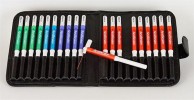Authors
V. Martinez, D. Fletcher, D. Bouhassira, D. I. Sessler, M. Chauvin.
Lab
Université Versailles Saint-Quentin, Hôpital Ambroise Paré, Centre d’Evaluation et de Traitement de la Douleur, INSERM, U-792, Versailles, France ; University of Louisville, Louisville, The Cleveland Clinic, Department of Outcomes Research, Kentucky.
Journal
Anesthesia and Analgesia
Abstract
BACKGROUND: Quantitative sensory testing (QST) allows precise characterization of sensory deficits and painful symptoms and may offer additional information on the pathophysiology of postoperative pain. METHODS: We evaluated 20 patients scheduled for total knee arthroplasty clinically and with QST before surgery, at 1 and 4 days after surgery, and at 1 and 4 mo after surgery. The clinical evaluation included preoperative pain and inflammation of the operative knee, postoperative assessment of pain at rest and during movement (Visual Analog Scale score), cumulative morphine consumption, and circumference and temperature of both knees. QST included thermal and mechanical (pressure) pain threshold measurements and assessment of responses to suprathreshold stimuli. Brush-evoked allodynia was also evaluated. Measurements were taken on the operative knee, contralateral knee, and on the hand as a control site. RESULTS: All patients had prolonged and severe pain before surgery and inflammation of the operative knee. Preoperative QST provided evidence of heat hyperalgesia in the inflammatory area on the operative knee, but absence of punctate or brush-evoked allodynia in the adjacent noninflamed area. Patients had intense postoperative pain, mostly induced by movement. Primary heat hyperalgesia was present on the operative knee on the first and fourth day after surgery, and was associated with punctate mechanical allodynia in the inflammatory area, but not in the adjacent noninflamed area. Postoperative morphine consumption was correlated with preoperative heat hyperalgesia (r = 0.63; P = 0.01). QST returned to baseline at the 4-mo evaluation. Only four patients had moderate knee pain induced by movement at that time. CONCLUSION: Heat hyperalgesia was the predominant QST symptom associated with perioperative pain after total knee arthroplasty, and was predictive of postoperative morphine consumption. IMPLICATIONS: Peripheral sensitization plays an important role in pain associated with knee arthroplasty in both the preoperative and postoperative periods.
BIOSEB Instruments Used:
Von Frey Filaments (Bio-VF-M)

 Douleur - Allodynie/Hyperalgésie Thermique
Douleur - Allodynie/Hyperalgésie Thermique Douleur - Spontanée - Déficit de Posture
Douleur - Spontanée - Déficit de Posture Douleur - Allodynie/Hyperalgésie Mécanique
Douleur - Allodynie/Hyperalgésie Mécanique Apprentissage/Mémoire - Attention - Addiction
Apprentissage/Mémoire - Attention - Addiction Physiologie & Recherche Respiratoire
Physiologie & Recherche Respiratoire
 Douleur
Douleur Système Nerveux Central (SNC)
Système Nerveux Central (SNC)  Neurodégénérescence
Neurodégénérescence Système sensoriel
Système sensoriel Système moteur
Système moteur Troubles de l'humeur
Troubles de l'humeur Autres pathologies
Autres pathologies Système musculaire
Système musculaire Articulations
Articulations Métabolisme
Métabolisme Thématiques transversales
Thématiques transversales Bonne année 2025
Bonne année 2025 